Retiring University President Richard Davenport sat down for a talk about 19 years at Minnesota State Mankato—during which the university became the flagship of the Minnesota State system. What follows are highlights of the interview.
Were you raised in an academic household?
Nobody in my family had gone to college. I grew up in kind of a bad situation. My mother died at age 32 of cancer. There were seven children at that time and a couple years later, my father remarried and had four more children. Adopted one along the way, too. So, I came from a big family. Everyone was expected to work, which I think is a blessing now. At the time I probably didn’t. I know now it really made you realize how important working for yourself was, and learning how to do that independently.
When I graduated from high school—I was the first to graduate from high school—I remember that I wanted to go to [University of Nebraska] at Kearney which was close to Grand Island, Nebraska, where I grew up. I was so upset because I didn’t have the money.
When it came time to go to college, I couldn’t really get help from my family because it was such a large family, and I didn’t have enough money saved, but I was offered a job with Nash Finch and one of their largest grocery chains was called Jack & Jill. They made me an assistant manager of a division. Finally, I had enough money and got a little scholarship money to go to Kearney. I told my Dad, I’ll be going to college next year. He says “You’re giving up a job like this, with benefits? You can move right up the chain here and manage one of these stores someday…”
So, his perception of the whole thing was “You have a sure thing—why would you give that up?” He wasn’t really happy, but he came around. When he came to my graduation, I think he was pretty proud.
Was there a family member or anyone else who influenced your career?
Because of all the children in the family there were just too many kids for one person to manage. So, my dad farmed us out in the summers. Some to each grandparent, some to aunts and uncles, and so forth. I was sent to my sister, who was recently married to a guy in ROTC in the Navy, and he was a graduate student at the University of Nebraska in Lincoln. Well, I thought this would be fantastic, but I drove her crazy. I think I was 12 years old at the time, she said “Larry, you gotta take him with you.” He taught astrophysics and he took me to all his classes. And I’d sit in the back of the room and take it all in. Admittedly, I didn’t understand what they were talking about, but I was fascinated because I had never been on a college campus and here I was watching these college students and my brother-in-law. I said to myself, this is what I want to do. I want to work at a University. And 12 years later, at age 24 I got my first University teaching job at Iowa State University. It was a premonition or whatever, I don’t know. But I did end up doing exactly what I dreamed about.
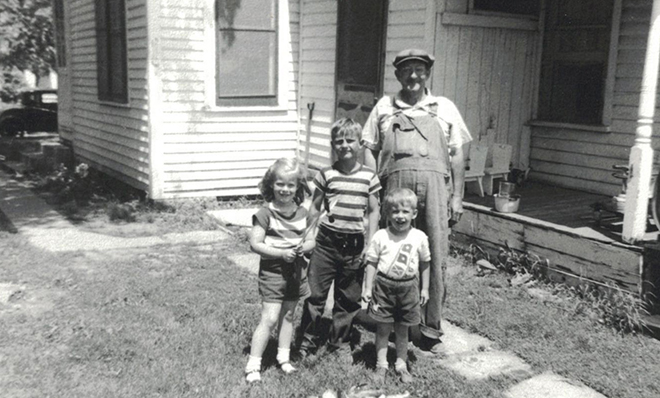
My brother-in-law made the biggest difference. He knew that none of my brothers or sisters had gone to college, he knew that I expressed interest in going to college, and he encouraged me on. He’d check in occasionally and see how I was doing. That’s the story how I ended up in higher ed.
What was it like coming from an academic background into a presidency?
Let’s just be really honest: There was a great deal of naiveté regarding how long it would take.
After two years at Iowa State, I obtained my doctorate and moved forward on a tenure track position. I remember talking to the president of Iowa State University, his name was James Hilton—he’s famous today—and I asked him what it was like to be president. President Hilton was a widower and was seeing the dean of home economics, who lived next door to me. Surprisingly, he shared stories about it. And I said, obviously naive, “You know, I think I’d like to be a president!”
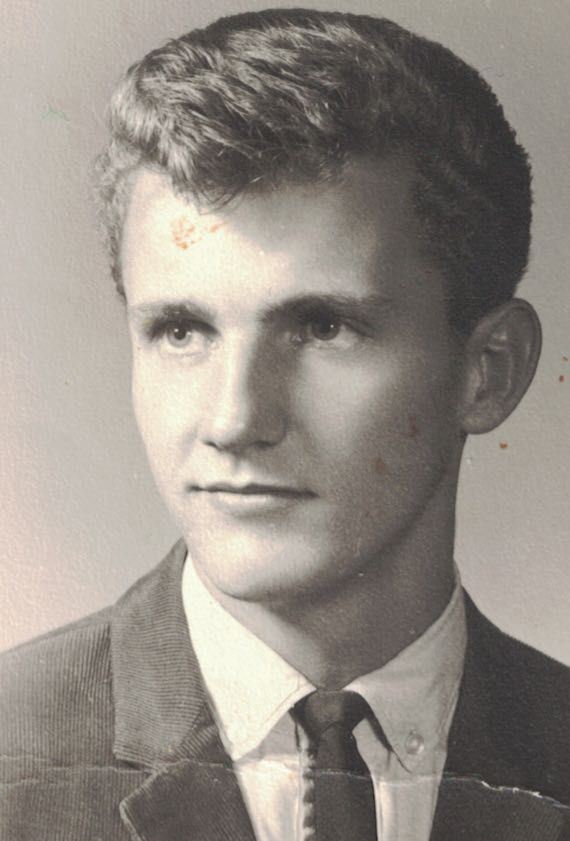
It’s sort of surreal. I’m 26 years old. I moved into this really nice neighborhood in Ames, Iowa, into the cruddiest house. It was really run down. And it turns out my neighbor was the dean of home economics. Across the street was the dean of off-campus programs and down the street about a block away was the dean of the veterinary school. So, I just happened to fall into the middle of all these university administrators. So anyway, not being afraid, and not knowing that much, I’d see them in the yard, and we’d talk about everything.
They must have thought, “Oh here’s a nice little guy, isn’t that something, he’s thinking about wanting to be a president.” President Hilton told me “Here is what I’m gonna recommend you do, Richard: I want you to go down to the University of Iowa in Iowa City and I want you to talk to the president. He’s a friend of mine. And ask him what he thinks about your career plans.”
I followed his direction. And the University of Iowa president gave me some really good advice. He said there’s no easy way. There are no shortcuts. I’ve used that line many, many times with leaders and administrators and others that I’ve worked with over the years. Those that try to take a shortcut, it just doesn’t work. So further conversation was: Get yourself tenured, move up in rank, become a professor, volunteer for all the committees possible so you can learn and understand the nature of a university and so forth. So, I followed his advice. As a matter of fact, I probably over-did it.
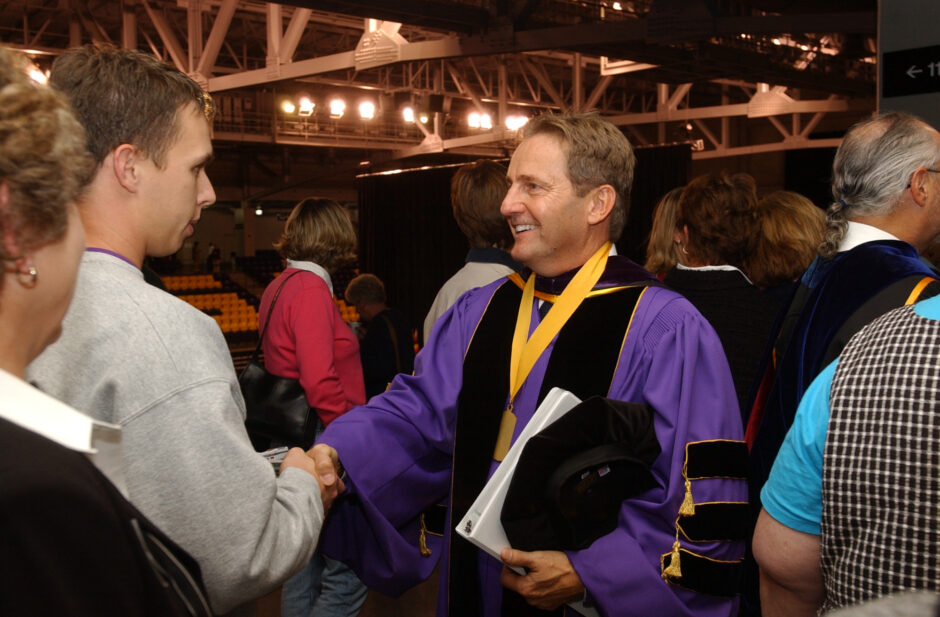
What were you looking for in cabinet members?
Start with the premise that no one can be everything. You can’t be an expert in finance and an expert in public relations and marketing and an expert in student affairs. I knew where my strengths were—they were on the people side. I really enjoy learning about others. So I made sure that the people who were part of the team were really good at their disciplines.
When a person starts with nothing, you study people and develop street smarts. I could interview people and had my own sense, intuition, my own barometer in figuring out what they knew and how hard they were willing to work. I think that made a difference. The other thing I did was purposely try to take the fear out of working for me. And put something in place of it: motivation and personal fulfillment.
When I hired anybody I’d say the same thing: Okay look, this is a partnership. I want to help you in your career, so what is it you want? Let’s figure out what it takes. And that’s really true for everybody I hired. What is it you want, what’s on your list? And one thing I learned is you can’t just say that. You really have to put something behind it. I provided lots of funding and opportunity for growth and development and I’m just so pleased that so many colleagues have been successful.
How does it feel seeing former cabinet members becoming leaders of their universities?
I’m not surprised. But I’m so very happy for them. They are good at what they do. I don’t know how much I might have contributed to their success, but I think they were given some of the right experiences that have helped them become outstanding leaders.
You’ve also been credited with knowing how to work well with legislators on behalf of the University. What was your approach to that part of the job?
I don’t try to be somebody I’m not. I think I can relate to a lot of people from different backgrounds. Glen Taylor is a role model in many ways. He and I have had some wonderful conversations over the years. He’s an inspiration for so many leaders. I often consulted him on big decisions and over the years our friendship developed. I admire his unassuming air and he is never a self-promoter. I’m proud to be a friend. There are many other role models, too. I don’t hold up being a president over anybody’s head … I can usually read people pretty well. I can be wrong, I’m not infallible, but I usually can. So I can work with the legislators and sit in their office and talk to them, drink coffee or whatever. Sometimes that’s all it took. New buildings and fundraising just don’t happen. It was always a little deal cutting. I know, for example, a number of the new buildings we got from the legislature were a result of those relationships.
I spent a lot of time listening to legislators on what they need or what they want, or what they’d like to see changed. I’ll give you one example. The legislative leaders up on the Iron Range wanted us to deliver an engineering program. They first went to the University of Minnesota and they turned them down. And then they went to the University of Minnesota Duluth, and they were not interested. And so a former state senator, Jerry Janezich, arranged a meeting with several legislators from the Iron Range. After I outlined the costs of delivering the expensive engineering program and noted that we could not handle the associated costs, they chimed in and said, “we’ll handle the costs and you deliver the program right here on the Range!” And, sure enough, they funded it and the program is as strong today as when we first launched it.” That was a good deal for both parties.
The other thing too, I would say, is I never made enemies. Hold your tongue, even if you’re not happy with something. As soon as you make an enemy, they’re probably an enemy for life. I took advantage of the opportunity to meet with the most important people in the state. I just figured out a way, I know somebody that knows somebody, we get an introduction or go out for dinner. It was always remembering my humble roots, but pushing the envelope.
Are you aware of your reputation of improvising on the spot?
I’m very much aware of what I’m doing. Before a speaking event, I’m walking through the audience and I’m meeting people; getting a vibe if you will. Then, I look at the script and I’ll review it briefly before speaking. I’m not one to read scripts verbatim. Many times I’ll evaluate and determine if the group is ready for a serious presentation, or if they’re going to want to hear something more light-hearted. So, yes, there were some times when I would redo the script to match the audience’s interest.
Now, am I infallible? Absolutely not. I have made a few mistakes when I’ve done that and there have been times when I thought, I should have stayed with the script. And the other thing I’ve learned is, no one wants to hear about you. Nobody wants to hear about what I’ve done. They want to hear what others have done. They want to hear how they have contributed. It’s a very simple formula. It’s never about you, so if you can take that ego and put it away in life and in work, you’ll be successful.
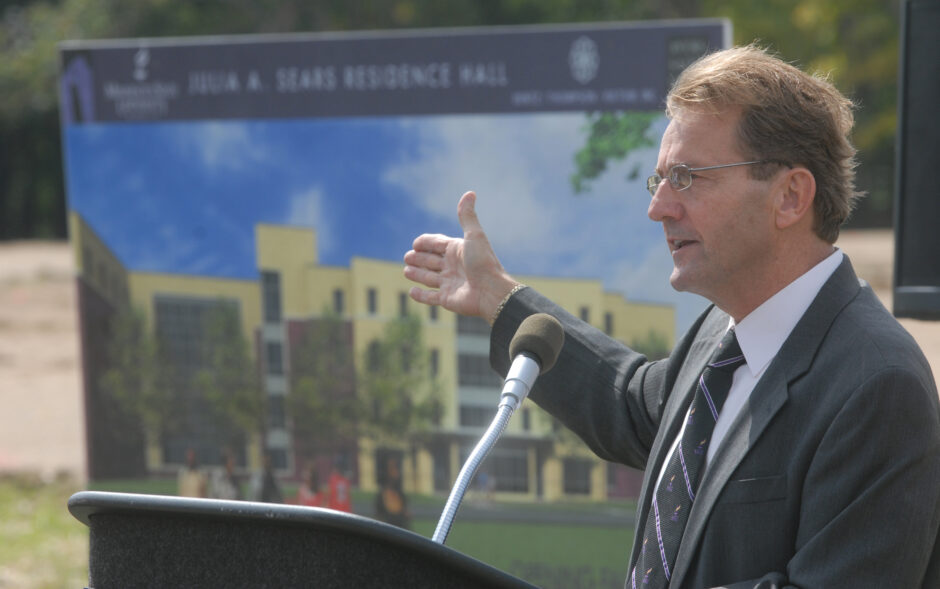
Where do you get your ideas?
The ideas are always there, but facilitated by watching, thinking and observing while considering how we can do better. I often try to see things from another’s point of view. Ideas are all around you if you just tune in to others. When I go to the national presidential meetings, I’d sit in the audience and listening intently while writing pages of notes about how we could enhance Minnesota State University. We could do this, or we could do that and just tuck those thoughts away. Somebody else’s ideas will frequently trigger a different one from myself.” In retrospect, I know some of my ideas stuck, but I never expected that all the ideas would be implemented. And, while I know some people rolled their eyes behind my back from time to time, I don’t think I ever turned anyone off because most people enjoy hearing how we can make our University a better place.
How does your wife Mary influence your approach to the job?
We really do make a great couple. I think in some ways we’re a bit alike as is often the case. She’s very humble, modest, she never brags about herself. I try to learn from her. And anytime I’d try to brag about her, she’d be a little bit embarrassed. I like to steer away from the limelight unless it’s part of my job; sometimes it is required in promoting the University.
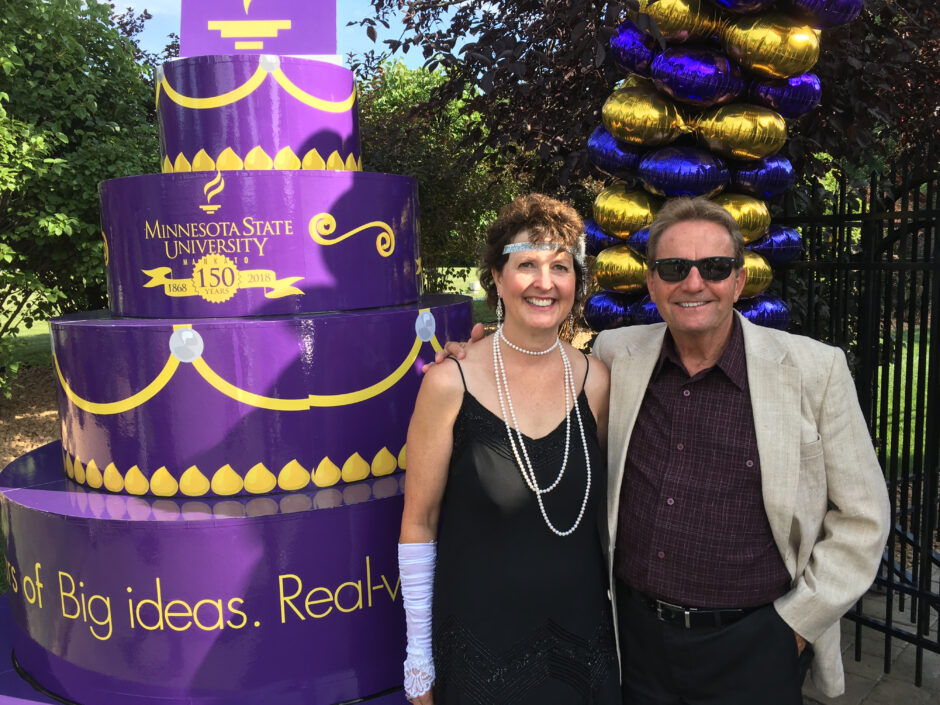
Mary’s father was in higher ed, he was the dean of students at University of Wisconsin—Stevens Point and became a vice president and went on to do some wonderful things. He went to Vietnam and brought back many, many families during the Vietnam War and afterwards. She had the experience of that understanding, learning empathy for those populations and others. She’s been highly successful and as a retired president of Rochester Community College, she is doing exactly what she wants to do. She loves the outdoors, flowers, gardens and travel. And get this: She loves old cars. So, I bought her a car: a 1947 Ford Convertible Deluxe. She loves that thing, but she’s had to learn how to drive a stick shift again. We both love history and enjoy exploring.
I know you hate these kinds of questions, but how do you hope the Richard Davenport “era” is defined?
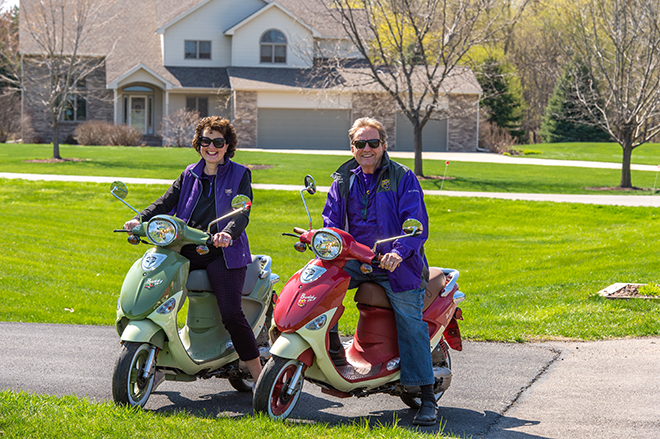
I think we launched a lot of leaders during this period. And I think the impact of the leaders coming out of this institution is going to have a profound impact on our world, our country, on Minnesota. Our graduates don’t necessarily come from wealthy families, but they have drive, strong work ethics and good values. I think we turned our University toward a goal of becoming the best public state university in Minnesota and the Midwest. And this will be an ongoing goal for the presidents that follow me. We will never be content as “average” and I believe our alums and students agree with me. And I think our Big Ideas focus was a step in that direction. Therefore, I think our graduates are going to be the ones who transform the University and its reputation. They’re the ones who will make a difference in our world. They aren’t afraid to roll up their sleeves, not afraid to work, not afraid to express their ideas. And if we started that during my tenure here, and that continues, that will be the legacy that I look for.
You realize you just defined yourself.
I did? Oh. (laughs)
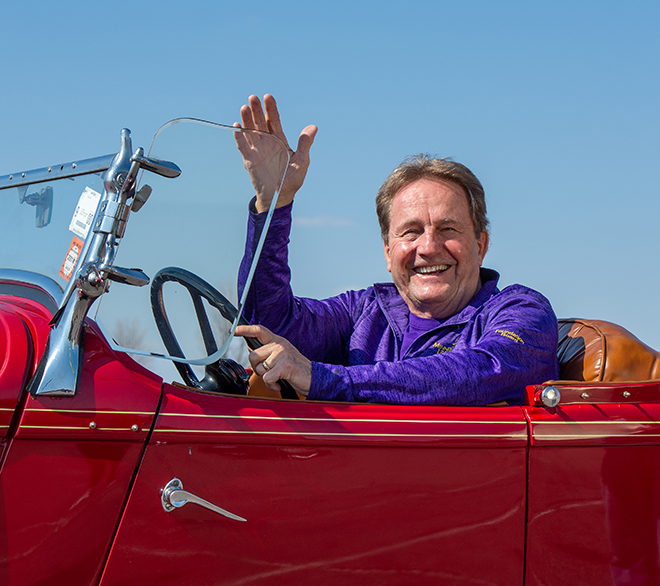
Speak Your Mind